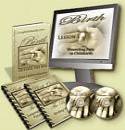What is Waterbirth?
History | Guidelines | Benefits | Q&A | Video Clips
What is waterbirth? Imagine your own personal pool, centered in a room filled with soft light, your favorite scent wafting past as you languish in its gentle warmth. The room is hushed with a subtle sense of anticipation. You sigh and settle deeper into the pool. This may not be the scene you picture when visualizing natural childbirth, but it is the reality for many women who are experiencing it.
History of Water Birth
While waterbirth may appear to be a new trend, it has been practiced for centuries around the globe, from Japan where women labored in the sea to Finland where women delivered in saunas. In the US, it gained more mainstream acknowledgment in the 1980s but its practice in traditional medical settings has been waning in recent years.
Prior to this time in the West, women remained in a tub for short periods
of time, such as in the shower or bath as a way to increase their comfort in early labour.
When questions were raised as to its safety, it was regarded with much skepticism with concerns also raised
about the ability to monitor the baby's condition while the mother was submersed in the water. However,
fetal monitoring is still possible during water births
through use of specialized equipment such as a doptone. Many
previously-supportive hospitals ceased offering it as an option, which left mothers seeking
waterbirth with the choices of birthing centers or having a home birth.
However, the body of research demonstrates no increase in negative outcomes for low-risk
mothers. A leading water birth advocate, Dr. Michel Odent, has conducted many research studies to
document its safety. After many years of hospital practice, Dr. Odent left mainstream medicine and
instead turned to providing homebirth and waterbirth options.
While few hospitals in
the US are equipped with tubs or birthing pools, women may be allowed to bring one for their own
use. If the hospital does not have a policy against it, a well-researched discussion with your care
provider may make this a viable option.
It's important to note that some caregivers are
uninformed about the benefits and safety of waterbirth. If you are considering it, be sure that your
care provider's decision for or against water birth is based on facts, not feelings. Once presented
with the true benefits and safety of giving birth in water, you may find that your caregiver is more
than willing to "go for it". Your birth may even convert them to waterbirth believers!
Additional information on the pertinent aspects of water birth can be found in the
following articles:
The Benefits of Giving Birth in Water
References
Cluett E R, Nikodem VC, McCandlish RE, Burns EE. Immersion in water in pregnancy, labour and birth. Cochrane Database of Systematic Reviews 2002, Issue 2. Art. No.: CD000111. DOI: 10.1002/14651858.CD000111.pub2.
Geissbühler V, Eberhard J: Waterbirths: A Comparative Study. Fetal Diagn Ther 2000;15:291-300 (DOI: 10.1159/000021024)
Garland, Dianne. Waterbirth: An Attitude to Care, Books for Midwives PR, UK, 2000 1 5947 7067 0
Harper, Barbara, RN. "Waterbirth Basics: From Newborn Breathing to Hospital Protocols". In Midwifery Today Magazine, 2000.
Geytenbeek, Jenny. "Evidence of effective hydrotherapy". In Physiotherapy. V. 88(9):514-529, 2002.
Ros, Andrea, Ricardo Felberbaum, Iris Jahnke, Klaus Diedrich, Peter Schmucker, and Michael Huppe. 2007 "Epidural anaethesia for labour: does it influence the mode of delivery?" In Archives of Gynecology and Obstetrics. V. 275(4):269-274(6).
Odent, M. (1998, March). Use of water during labor—updated recommendations. MIDIRS 8 (1): 68-9.
Gilbert, R., Tookey, P. (1999, Aug. 21). Perinatal mortality and morbidity among babies delivered in water: surveillance study and postal survey. BMJ 319(7208): 483-7.
Cammu H, Clasen K, Van Wettere L, Derde MP. 'To bathe or not to bathe' during the first stage of labor. Acta Obstet Gynecol Scand 1994;73:468-72.
Ohlsson G, Buchhave P, Leandersson U, Nordstrom L, Rydhstrom H, Sjolin I. Warm tub bathing during labor: maternal and neonatal effects. Acta Obstet Gynecol Scand 2001;80:311-4.
Rush J, Burlock S, Lambert K, Loosley-Millman M, Hutchison B, Enkin M. The effects of whirlpool baths in labor: a randomized, controlled trial. Birth 1996;23:136-43.
Eriksson M, Mattsson LA, Ladfors L. Early or late bath during the first stage of labour: a randomised study of 200 women. Midwifery 1997;13:146-8.
Royal College of Midwives. 2006. "Immersion in water during labour and birth." Joint Position Paper no. 1. London, Royal College of Obstetricians and Gynecologists and Royal College of Midwives.
Return from Waterbirth to Giving Birth Naturally Home
Page Last Modified by Catherine Beier, MS, CBE
Most Popular
How to Use Acupressure to Induce Labor
Childbirth Relaxation Script MP3s
Nutrition During Pregnancy - Nix the Notion of Eating for Two
Looking for a Birth Professional? Search our Provider Directory
Online Childbirth Classes
Choose 7 week, 12 week, or Self- Paced online childbirth classes available wherever and whenever you need them.
Featured Birth Story
Vanessa's natural birth story shows that when birth is left alone to proceed as it should, it waits for no one - not even doctors or midwives.
Free Pregnancy Tickers
Create a free pregnancy ticker to post on your blog, website, Facebook profile or favorite social media...




